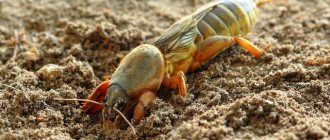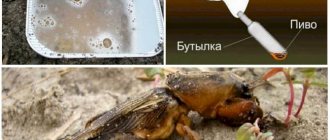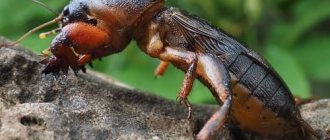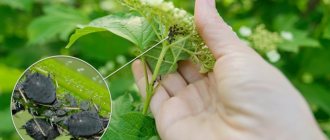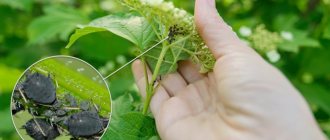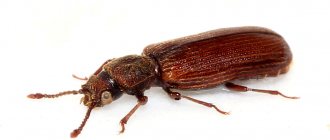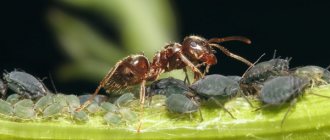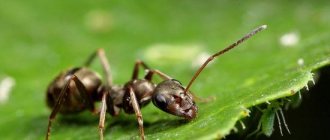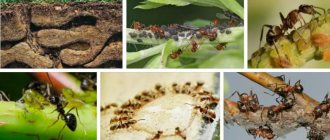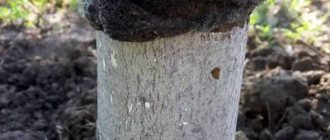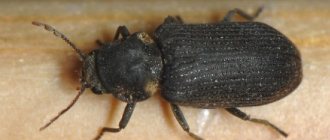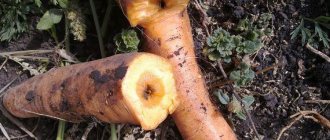Home / Pests and diseases
Back
Published: 07/23/2019
0
Rate this post
Mole cricket (cabbage weed, crayfish, crayfish) belongs to the group of dangerous pests of agricultural crops. A voracious and prolific insect causes serious damage to plantings, damaging roots, root crops, and young plant shoots.
Despite the huge number of means, methods of destroying and repelling the pest, it is not always possible to achieve the desired result. Therefore, gardeners are always looking for: how to deal with mole crickets, what technology is effective, and at the same time as safe as possible for humans.
- 1 Features of pest control
- 2 Use of folk remedies
- 3 Setting up traps
- 4 Lures
- 5 Plants are protectors
- 6 Natural enemies of cabbage grass
- 7 Biological drugs: is it worth using?
- 8 Repelling mole crickets
- 9 Features of the use of insecticides 9.1 Protection of seedlings
- 9.2 Expanding the range of drugs
Features of pest control
The mole cricket on the site lives in the soil, arranging numerous burrows, nesting places, and storerooms underground. It rarely appears on the surface, quickly runs away from danger, flies, swims quickly, which seriously complicates the fight (see photo of the mole cricket).
It prefers garden plots with manured, moist soil, vigilantly standing guard over its possessions, protecting nests with clutches of eggs and larvae.
To destroy the pest in a summer cottage, various methods and technologies are used. A number of means are used to repel cabbage grass, others are used to exterminate and reduce the population. In the list of funds:
- traps;
- bait;
- electronic and homemade repellers;
- insecticides;
- biological drugs;
- compositions according to folk recipes;
- mechanical methods.
There is no single effective method of control; it is advisable to take an integrated approach using various means. The use of folk recipes gives results as a preventive measure, as well as with a small number of insects on the site. If there is a massive pest invasion, then “chemistry” has to be used. It is difficult to get rid of mole crickets in the garden forever, but for some period of time it is quite achievable.
On a note! To destroy the mole cricket, you need to involve your neighbors in the country. Only through joint efforts will it be possible to cope with a serious “enemy”.
Damage to mole crickets in the garden
The mole cricket (cabbage moth) looks extremely unattractive, but a much greater danger is the damage that the insect causes to garden crops. If cabbage weed has been spotted on your site, it is imperative to combat it, since the insect will definitely lay eggs, from which larvae will later hatch and the pest population will increase significantly, and with it a danger to garden crops.
Note: One adult can gnaw on the roots of more than 10 plants per day, which will invariably lead to a decrease in yield. Insect larvae that appear at the end of summer only enhance the negative effect.
Adults and larvae dig deep passages and tunnels in the ground, in the process gnawing the roots of any plants encountered along their path. Most often, the pest is found on cucumber plantings, but absolutely any plant can be damaged by insect activity (Figure 7).
Figure 7. External features of the pest
If a mole cricket has damaged a young plant, it will be greatly weakened and pulling it out of the soil will not be difficult. If already mature and mature specimens are damaged, diseases and a decrease in yield may appear.
Cabbage weed is especially dangerous for potatoes and root vegetables. The insect eats the pulp of such vegetables. As a result, large cavities form in the root crops, which reduces their marketability and does not allow the crop to be stored for long-term storage. It is no less dangerous for the garden. Despite the fact that this pest is not capable of gnawing the roots of adult plants, it can significantly damage the root system of young seedlings of fruit and berry and ornamental crops.
The use of folk remedies
Gardeners have accumulated a wealth of experience in various means of exterminating and repelling cabbage grass. Some of them are unusual, others are traditional, known to summer residents of various regions.
They save themselves from the voracious earth mole with the help of birch tar and ammonia, onion peels and crushed eggshells. As assistants for summer residents:
- garlic;
- coniferous branches;
- kerosene;
- matches;
- chicken droppings;
- laundry and tar soap, shampoo;
- naphthalene;
- iodine;
- turpentine.
When using the products, we must remember that thoughtlessly watering the beds with kerosene or laying out large quantities of naphthalene will lead to contamination of the area and deterioration of the quality of the soil.
The effectiveness of each method is tested in practice, and in any case it is necessary to approach folk recipes and recommendations wisely and without excessive fanaticism.
Setting up traps
To exterminate insects, traps are built in gardens and garden plots, luring mole crickets with honey, beer, and fermented jam. The basis of the traps are containers (plastic bottles, glass or tin cans) buried in depressions in the soil. A little beer or other bait is poured into them and covered with a board or piece of tarpaulin on top.
Holes are dug in places where the pest is expected to live, and traps are checked every 10-15 days.
Terradox
The remedy for mole cricket Terradox is an insecticide with a prolonged effect. It is used to protect vegetable, berry crops, and fruit seedlings from pests. Characteristics of the chemical:
- Release form: granular product packaged in 100 or 200 g.
- Active ingredient: diazinon. Its concentration is 40 g per 1 kg of the drug.
- Duration of action: Terradox protects the treated area from mole crickets for 2–4 weeks.
- When to use: the insecticide is applied in the spring before planting garden crops or before winter. Laying in the ground should be carried out in the morning or evening in calm weather. When it rains, the poisonous effect is significantly reduced.
- Method of application: scatter Terradox (20 g per 10 m²) and bury it in the soil by loosening.
- Toxicity: Terradox is not harmful to humans or pets.
- Price: 100 g – 40 rubles; 200 g – 65 rub.
- Shock wave therapy - cost and reviews. Indications for shock wave treatment and contraindications
- Diet for diseases of the gastrointestinal tract
- How to plant strawberries
Lures
In a summer cottage, it is easy to make baits to kill crayfish using different grains. Poison (boric acid, insecticides) is added to cereals as active ingredients.
Several recipes:
- steamed grain (corn, wheat) + Metaphos;
- steamed peas (1-1.5 kg) + Regent preparation (ampoule);
- 0.5-1 kg of porridge (buckwheat, pearl barley, oatmeal) + Parachute (ampoule);
- crumb of black bread + sulfur of matches.
Baits are scattered between rows in beds, under plants, and placed in pest holes.
On a note! To attract mole crickets for scent, add a couple of tablespoons of unrefined vegetable oil to porridge or steamed grain.
Such baits must be used carefully, keeping domestic animals, chickens, geese, and ducks away from the area.
Boverin
A new generation insecticide, Boverin, is a biological product. By adding it to the soil of a site, you can simultaneously get rid of several types of insect pests. Characteristics of Boverin:
- Release form: liquid or light powder.
- Active ingredient: spores of the fungus Beauveria bassiana, located in the nutrient substrate. When ingested by a parasite, they begin to grow and cause the death of the insect.
- Duration of action: fungal colonies continue to grow in moist soil even after the death of the pest, so their action is active throughout the warm season.
- When to use: the optimal time for the growth of a colony of Boverin fungi is spring-autumn, when the ambient temperature is in the range - + 18-28 ° C with a humidity of 80-85%!
- Directions for use: add 2 tbsp to 200 g of the drug. spoons of vegetable oil and stir until smooth. Spread the resulting mass into holes and row spacing to a depth of 2–10 cm. Product consumption is 200 g per 100 m².
- Toxicity: Boverin is not toxic, but all manipulations with fungal spores must be carried out using personal protective equipment (gloves and a respirator) to prevent them from entering the human body.
- Price: 200 g – about 50 rubles.
- Recipe for classic cream for Napoleon cake
- What rubella looks like
- Belyashi dough - step-by-step recipes. How to prepare delicious belyashi dough quickly and easily, video
Plants are protectors
It has been noticed that some strong-smelling herbs and flowers repel cabbageweed. The insect has a well-developed sense of smell; foreign specific odors depress and disturb the pest. This is used by summer residents who plant marigolds and chrysanthemums around the perimeter of the beds.
The mole cricket cannot stand the smell of aspen, but in this case they do without planting trees. Prepare aspen branches or pegs and stick them into different places in the garden. It has been tested that the pest soon leaves uncomfortable places, preferring to breed in favorable conditions.
What do affected plants look like?
Mole crickets feed on the roots and stems of vegetable crops and damage young shrubs, grasses, and bulbous flowers. When examining the plants, it appears that someone has cut the stems. In beds with carrots or beets, all the tops lie on the ground, as if a scythe had been passed over it. Marks remain on root vegetables and flower bulbs: the mole cricket completely gnaws through them, leaving behind voids. As a result, such vegetables are no longer suitable for further use.
Reasons for the appearance of pests: 1. Use of fresh organic matter as fertilizers. Moreover, this way pests can spread from neighboring gardens. 2. The insect overwinters in manure heaps and compost pits, and then is introduced into the soil. 3. Waterlogging of mulched areas or close proximity to groundwater. The moisture does not have time to evaporate, and the soil remains constantly wet. This environment is ideal for mole crickets.
Natural enemies of cabbage grass
Birds are not averse to feasting on insects: rooks, starlings, crows. In the southern regions, storks actively exterminate cabbageweed; the main thing is to attract the insect’s natural enemies to the site.
To do this, they build birdhouses, feed the birds, and do not destroy the nests.
Hedgehogs will help reduce the population of earthen crayfish. For these useful animals, secluded places are arranged in areas (in lowlands, near rotten trees, near hedges). Another group of helpers are ground beetles, lizards, shrews, and centipedes.
A species of burrowing wasp, Larra anathema, poses a serious danger to cabbageweed. The solitary black wasp is known for its care of offspring and its original way of laying eggs. She chooses a mole cricket for the nest, looking for insects in the underground labyrinths of burrows. Drives the pest to the surface, stings, causing temporary paralysis and during this time manages to lay one egg under the insect’s foot.
After some time, the mole cricket comes to life, crawls into its hole, and the sand wasp larva successfully develops, parasitizing on the body of the insect. Shortly before the wasp pupates (approximately 15-30 days after laying), the mole cricket dies. This is how the Larra wasp helps a person fight a dangerous pest.
Chops
An effective, brightly colored granular insecticide designed to kill pests living in the soil. These include mole crickets, beetleworm larvae, and wireworms.
Release form
This medicine for mole crickets consists of red and green granules placed in waterproof bags. Weight - 100 g.
Chemical composition
The main substance is malathion 50 g/kg.
Mechanism of action Once in the insect's body, malathion is converted into a physiologically active substance with a very high toxic ability.
With frequent use of the product, insects begin to develop resistance to malathion . The body of such pests develops the ability to destroy the chemical, turning it into a non-toxic compound.
Duration of action
Death occurs 3 hours after the drug enters the mole cricket’s body. The duration of toxic activity is up to 20 days after placement in the ground.
Compatibility with other drugs
Malathion, among other organophosphorus compounds, combines well with most known insecticides and fungicides.
When to use?
The first laying of granules is carried out 8-10 days before planting seedlings and sowing seeds in moist soil. It is advisable to carry out the procedure after rain or shortly before it starts.
Mode of application
The poison from the mole cricket is placed in grooves or holes up to 5 cm deep , placing Rubit in the places most often visited by the mole cricket - heaps of manure and compost, beds and holes, row spacing, tree trunk circles. The granules are covered with earth on top. The consumption rate is 6-10 g every half meter.
Toxicity
Rubit is a moderately toxic product and belongs to class 3 hazard for people , mammals and birds.
The mole cricket is extremely voracious and she doesn’t care at all about how much work and effort we put into our dacha affairs. Read the advice of our experts on effective methods of combating this insect, including folk remedies.
Biological drugs: is it worth using?
Nowadays, biological products that are considered environmentally friendly are actively used in pest control. Another “advantage” of such products is the lack of resistance in insects, which is often noted with traditional insecticides.
Operating principle: colonization of the pest’s body by fungi or predatory insects that parasitize at the expense of the host (mole cricket, wireworm).
The following remedies will help you get rid of mole crickets:
- Nemabact is a symbiosis of bacteria and a certain subspecies of nematode. The predator is distinguished by its reproduction speed, when used it gives an effect of up to 70-80%;
- Antonem-F is a drug similar to Nemabact, differing only in the type of nematode;
- Boverine is a drug based on the spores of a fungus of the Deuteromycetes species, which causes the disease muscardinosis. The peculiarity of the action is germination in the body of the mole cricket, poisoning of larvae and adults, infection of insects in the entire population.
But the use of biological agents is associated with difficulties:
- effective only at certain soil moisture and temperature levels;
- The preparation of biological products requires strict adherence to the recipe and deadlines.
Description of the insect and the damage caused
The mole cricket is a dark brown insect. The length of the body is 5–8 cm. The pest has a gnawing type jaw apparatus. The body of the mole cricket is covered with a hard shell. At the base of the insect's cephalothorax are digging legs. Thanks to them, the mole cricket moves underground.
At the end of the pest's abdomen are thread-like appendages. The front claws are well suited for digging in the soft soil of beds and agricultural fields. The activity of the insect depends on the time of year and the state of the environment. The peak of the harmful activity of the mole cricket occurs in the summer. The insect is omnivorous.
The mole cricket absorbs the root part of cultivated plants and leaf mass. By digging through winding underground passages, it sprinkles soil on the seedlings, which leads to suppression of their vital activity and death. Owners of dachas and vegetable gardens are trying to get rid of mole crickets forever in order to ensure good productivity of their plots.
Repelling mole crickets
Simple but effective repelling methods include the installation of special devices (turntables, electronic devices).
On a note! Widely advertised ultrasonic devices are not suitable for repelling mole crickets and moles. Digging species of animals and insects do not perceive ultrasound, so repellers with infosound (oscillations at low frequencies) are used for them.
There are various models of devices on sale that operate at radii from 400 to 1500 meters.
Craftsmen make turntables with blades in their summer cottages using ordinary plastic bottles. Placed on stakes, such weather vanes rotate in the wind, creating vibration in the surface layers of the soil. This scares away the cabbage grass, and the pest leaves the area.
Appearance of the pest
The mole cricket is a large garden pest, so it will be difficult to confuse it with any other creature. You can recognize this representative of the fauna by 10 features of its appearance.
These include:
- size 4–5 cm;
- on the small head of the mole cricket there are antennae, eyes, mouth and tentacles;
- abdomen approximately 3 times longer than cephalothorax;
- at the end of the body there are paired processes one cm long;
- the forelimbs of the mole crickets are turned inward;
- there are 4–5 sharp spines on the hind legs;
- the length of the fine-scaled wings exceeds the size of the body;
- the limbs are colored brown, and all other parts of the body are brown.
Features of the use of insecticides
In case of mass pest invasions, there is no other way but to use “chemistry”. Not every summer resident agrees to use insecticides, but faced with the threat of crop loss, one has to make a choice.
The list of chemicals includes both universal remedies for garden pests and specialized ones (only for mole crickets). Approved medications are used, strictly observing processing times, dosages, and protective measures during work.
It is necessary to follow the instructions regarding the time intervals between the procedure and harvesting (waiting periods), take into account the hazard class of the insecticide (for humans, for bees, for inhabitants of water bodies). The permitted frequency of treatments is also indicated in the instructions.
Among the popular remedies among summer residents, we note:
- chops;
- Thunder;
- Parachute;
- Frontier;
- Grizzly;
- Wofatox.
The use of these chemical insecticides is described in detail in articles on our website.
Other modern insecticides (concentrates, granules, powders) are also used in the fight against mole crickets (see table).
| Name of insecticide | Number of treatments | Active substance | Hazard Class | Waiting period |
| Terradox | 2 | Diazinon | III | 60 days |
| Bankol | 2 | Bensultap (nicotinoid) | III | _ |
| Phenaxin Plus | 2 | Malathion | III | 20 days |
| Medvetox | 2 | Diazinon | III | 60 days |
| Tzipi | 2 | Cypermethrin | II | 7 days |
| Rembek | 2 | Boric acid | _ | _ |
| Anti Medvedka | 1 | Imidacloprid | III | _ |
In addition to treating plantings, insecticides are added to baits as poisons.
Seedling protection
In farms where crops are grown over large areas, seedling treatment technology is used to protect against mole crickets. The most commonly used solution is the insecticide Aktara, known to gardeners as a remedy against the Colorado potato beetle on potatoes, tomatoes, aphids, and thrips.
On a note! The manufacturer of Aktara is Singenta. It is advisable to purchase the insecticide in the manufacturer's original packaging.
For treatment, prepare an aqueous solution (take 15 grams of Aktara per 10 liters of water), soak the roots of the seedlings for 1-1.5 hours, then plant them in a permanent place in greenhouses or on ridges without washing. From experience, the mole cricket is careful not to attack such plants, so the seedlings adapt well and grow quickly.
We are expanding the range of drugs
In addition to traditional insecticides designed to combat mole crickets, gardeners have recently been using other preparations. This is due to the fact that insects become accustomed to certain types of chemicals, which reduces their effectiveness.
For baits (adding steamed grain or peas to porridge), use Regent 800 in granules, as well as liquid concentrate Regent 25. These fipronil-based products have gained popularity in the fight against the Colorado potato beetle, but summer residents also successfully use them to protect plantings from cabbage weed. .
Rating of the best remedies for mole cricket
| Nomination | place | Name of product | price |
| Rating of the best remedies for mole cricket | 1 | Medvetox | 46 ₽ |
| 2 | Frontier | 17 ₽ | |
| 3 | Thunder | 15 ₽ | |
| 4 | Rubit Rofatox | 25 ₽ | |
| 5 | Rembek | 35 ₽ | |
| 6 | Terradox | 65 ₽ | |
| 7 | Nemabact | 730 ₽ | |
| 8 | Grizzly | 17 ₽ | |
| 9 | Medvegon | 19 ₽ | |
| 10 | Biodischarge | 85 ₽ | |
| 11 | Phenaxin Plus | 37 ₽ | |
| 12 | Extraflor | 39 ₽ |
Medvetox
Rating: 4.9
The first is a contact-intestinal type drug, which outperforms the others in terms of effectiveness. The toxin is able to quickly rid plantations of mole crickets, aphids, wireworms, cabbage and onion flies, weevils, and ants. Poisoned granules have an attractive smell and taste, so there is no doubt about the death of pests. Within 3 days, the area is completely free of them, which allows the plants to develop and produce the expected harvest.
The product, despite its high toxicity to mole crickets, is absolutely safe for the soil and its beneficial inhabitants. After 20 days, it breaks down into harmless components. It is enough to use Medvetox once at the beginning of the season.
According to reviews, this product is the best among analogues, as it helps to destroy several types of pests not only in the treated area, but also in neighboring ones. The product is very economical. 1 granule is enough to kill 1 mole cricket. The drug is ready for use without additional preparation.
Advantages
- long-term activity after treatment;
- minimum consumption;
- environmental safety;
- unique bait composition;
- without addiction among pests.
Flaws
- not detected.
Frontier
Rating: 4.8
The silver rating is for a universal product that helps gardeners destroy pests such as mole crickets, aphids, wireworms, and cockchafers. All these insects are capable of causing significant damage to plantations, including complete destruction of the crop. “Rubezh” is not addictive and does not have a negative effect on people or beneficial insects.
The death of the bulk of poisoned pests occurs in the first 3 hours. In the next day, the surviving mole crickets experience paralysis and death. After adding granules to the soil, their effect lasts up to 3 weeks. After 3 days you can begin manual work. The drug is ready for use; it does not need to be mixed with water.
Thanks to the synthetic flavors included in the composition, the product attracts adults. The larvae also die after contact with them, completely freeing the garden from the presence of harmful insects. Many experienced gardeners use this particular product and recommend it to other gardeners.
Advantages
- low toxicity to humans, plants, animals;
- rapid destruction of various types of pests;
- minimal resistance;
- economical consumption.
Flaws
- dangerous for bees, therefore limit use during the flowering period of honey plants.
Thunder
Rating: 4.7
Third place in the ranking goes to a product that quickly deals with garden pests and protects vegetables, berries, ornamental plants, coniferous and deciduous shrubs from them. High efficiency is achieved due to the high content of toxins, so the product must be used with caution near bodies of water and avoid being eaten by poultry. At the same time, it is absolutely safe for soil microorganisms, earthworms, and does not affect plant growth.
8 active components form a scent that attracts adult insects more than the roots of young shoots. Microgranules do not require dilution with liquid. Rapid death occurs within 1-2 days. The product has a long-lasting effect, the duration of which is 3 months.
According to reviews, the drug has proven to be equally effective on vast agricultural lands, small vegetable gardens, in open ground and in greenhouses. Its efficiency is proven by its consumption, which is only 20 g per 7 square meters. m. At the same time, the packaging is low cost.
Advantages
- destruction of adult insects and larvae;
- long period of protection;
- super tempting smell for pests;
- for all types of soil.
Flaws
- not detected.
Rubit Rofatox
Rating: 4.6
Fourth in our rating is a product created on the basis of the insecticide fipronil. This is a powerful substance that is destructive to mole crickets, but is absolutely safe for agricultural and ornamental crops, people, and pets. It does not accumulate in the soil and quickly breaks down into harmless compounds. The composition includes strong aromatic additives that attract insects, but are practically not felt by humans. The granules are colored red and green, reminiscent of plant rhizomes.
The adult dies within 3 hours. During this time, she manages to come into contact with other insects and larvae, which subsequently also die. After treating the area, the drug is valid for another 20 days.
Rofatox is used at any time of the summer season for both preventive and therapeutic purposes. This can be immediately before planting, during the growing season, or as needed. Summer residents highlight this remedy as one of the most effective. It perfectly combines performance and environmental friendliness.
Advantages
- for all phases of mole cricket growth;
- rapid death on any size area;
- does not harm biobalance;
- enhanced taste and aroma properties.
Flaws
- not detected.
Rembek
Rating: 4.5
The fifth nominee in the rating is a universal drug that helps destroy mole crickets, Colorado and May beetles, wireworms, aphids, and caterpillars. It is absolutely harmless to ornamental plants and agricultural crops, but in a short time it clears the area of pests and preserves the harvest. The main active substance is boric acid. It does not have a negative impact on human health compared to chemical analogues.
The composition includes onion peels, vegetable oil, kerosene, red pepper, chrysanthemum leaves. The product is available in the form of granules. There is no need to make any preparations before the event. The substance crumbles when planting seedlings, under adult bushes, directly into insect burrows.
The drug has a pleasant smell and taste for the pest and is eaten with pleasure. According to the instructions, its effect lasts up to 2 weeks. According to reviews, this time is longer and amounts to 1 month. During this period, thanks to the chain reaction method, not only adult individuals die, but also larvae in burrows.
Advantages
- multifunctional product;
- non-toxic to people and plants;
- long lasting effect;
- destruction of the entire colony.
Flaws
- not detected.
Terradox
Rating: 4.4
In sixth place in the ranking is a drug that affects all harmful soil insects. It is used to protect potatoes, tomatoes, cucumbers, berries, coniferous and deciduous trees, and ornamental crops, providing reliable protection and accelerating their growth. The product belongs to a low toxicity class. Humans, animals, birds, earthworms are out of the risk zone.
